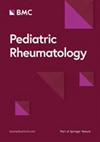川崎病患者的眼部表现、实验室检查结果、超声心动图检查结果和静脉注射免疫球蛋白耐受性之间的关系
IF 2.8
3区 医学
Q1 PEDIATRICS
引用次数: 0
摘要
本研究调查了川崎病(KD)眼部受累的发生率,并评估了眼部表现、实验室检查结果、超声心动图检查结果和静脉注射免疫球蛋白(IVIG)耐药性之间的关系。我们在 2021 年 6 月至 2023 年 3 月期间对 58 名 KD 患者进行了横断面研究。所有患者在开始治疗前的急性期都进行了全面的眼科检查和超声心动图检查。我们分析了所有患者的年龄、性别、白细胞(WBC)计数平均值、血小板计数、红细胞沉降率(ESR)、C反应蛋白(CRP)、丙氨酸氨基转移酶(ALT)和天门冬氨酸氨基转移酶(AST)水平、超声心动图结果和 IVIG 反应,并将眼部受累组与未受累组进行了比较。双侧急性结膜炎的发病率为 70.7%,急性葡萄膜炎的发病率为 30%。与没有葡萄膜炎的患者相比,葡萄膜炎患者的冠状动脉扩张率和 IVIG 耐药性明显更高,白细胞、血小板和 CRP 的平均水平也更高。(P 0.05).此外,任何检查项目与急性双侧结膜炎之间均无明显相关性。KD 葡萄膜炎与冠状动脉扩张、IVIG 耐药性、较高的白细胞计数、血小板计数和 CRP 水平明显相关。本文章由计算机程序翻译,如有差异,请以英文原文为准。
Relationship between ocular manifestations, laboratory findings, echocardiographic findings, and intravenous immunoglobulin resistance in Kawasaki disease
This study investigates the incidence of ocular involvement in Kawasaki disease (KD) and evaluates the relationship between ocular manifestations, laboratory findings, echocardiographic findings, and intravenous immunoglobulin (IVIG) resistance. We conducted a cross-sectional study with 58 KD patients from June 2021 to March 2023. For all patients, a complete ophthalmologic examination and echocardiography were performed in the acute phase before starting the treatment. We analyzed the age, sex, mean of white blood cell (WBC) count, platelet count, erythrocyte sedimentation rate (ESR), C-reactive protein (CRP), levels of alanine aminotransferase (ALT) and aspartate aminotransferase (AST), echocardiographic findings and IVIG responses for all patients and compared the group with ocular involvement with the group without involvement. The incidence of bilateral acute conjunctivitis was 70.7%, while that of acute uveitis was 30%. Patients with uveitis had significantly higher rates of Coronary artery dilatation and IVIG resistance, as well as higher mean levels of WBC, platelet, and CRP compared to those without uveitis. (P < 0.05). Additionally, the age of patients with uveitis involvement was lower than those without involvement. No significant relationships existed between ESR, AST, or ALT values and uveitis (P > 0.05). Furthermore, no significant correlations existed between any examined items and acute bilateral conjunctivitis. Uveitis in KD is significantly associated with coronary artery dilatation, IVIG resistance, higher WBC count, platelet count, and CRP level.
求助全文
通过发布文献求助,成功后即可免费获取论文全文。
去求助
来源期刊

Pediatric Rheumatology
PEDIATRICS-RHEUMATOLOGY
CiteScore
4.10
自引率
8.00%
发文量
95
审稿时长
>12 weeks
期刊介绍:
Pediatric Rheumatology is an open access, peer-reviewed, online journal encompassing all aspects of clinical and basic research related to pediatric rheumatology and allied subjects.
The journal’s scope of diseases and syndromes include musculoskeletal pain syndromes, rheumatic fever and post-streptococcal syndromes, juvenile idiopathic arthritis, systemic lupus erythematosus, juvenile dermatomyositis, local and systemic scleroderma, Kawasaki disease, Henoch-Schonlein purpura and other vasculitides, sarcoidosis, inherited musculoskeletal syndromes, autoinflammatory syndromes, and others.
 求助内容:
求助内容: 应助结果提醒方式:
应助结果提醒方式:


